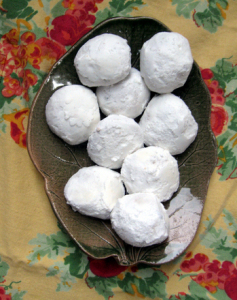Mexican Wedding Cookies
As can be guessed from the name of these scrumptious treats, they are a necessary component of any Mexican wedding or special occasion! Lots of flavor is extracted from just a few simple ingredients in this traditional “biscochito” recipe, said to have originated in Europe and been brought to Mexico via Spain. This tasty activity provides a fantastic opportunity to teach your little one about international foods!
Vary this recipe by choosing your family’s favorite type of nut. Some recipes use pecans, while others use hazelnuts, walnuts, or pralines.
Yield: about 2 dozen cookies.
What You Need:
- 8 ounces butter
- 1/2 cup powdered sugar
- 1 tablespoon vanilla
- 1/2 teaspoon salt
- 1 cup very finely chopped almonds (or nut of your choice)
- 2 1/2 cups sifted all-purpose flour
- Powdered sugar for dusting
What You Do:
- Preheat oven to 350° F.
- Beat the butter and powdered sugar until light and fluffy, about 10 – 15 minutes.
- Have your child add vanilla, salt, and almonds.
- Once thoroughly beaten, remove from the mixer and stir in flour. Do not over mix! The dough should be fairly coarse.
- After showing him an example, ask your child to form the dough into small football shapes.
- Have your child lightly butter a baking sheet.
- Ask your child to place the dough-balls onto the baking sheet and bake them for about 10 minutes, or until they begin to turn golden brown on the bottoms.
- When you see the slightest bit of color, make sure to remove the cookies from the oven and place them on a cooling rack.
- While the cookies are still warm, place them in a small bowl with powdered sugar and toss them gently until fully coated. When the cookies are cool, they are ready to be served!

Kate is the founder of Learn and Grow Books, which is a website for parents and teachers of pre-K children.

